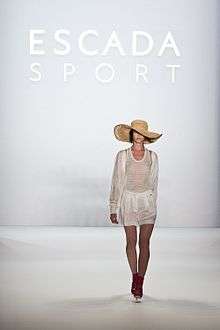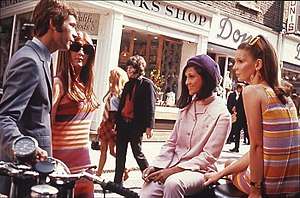Fashion capital

A fashion capital is a city which has a major influence on international fashion trends and in which the design, production and retailing of fashion products – plus events such as fashion weeks, awards and trade fairs – generate significant economic output.
The cities considered the global "Big Four" fashion capitals of the 21st century are Milan, London, New York and Paris.[1]
Definition of a fashion capital
A fashion capital assumes leadership role in clothing and design. In addition, fashion capitals usually have a broad mix of business, artistic, entertainment, cultural and leisure activities and are internationally recognised for having a unique and strong identity.[2] It has also been noted that the status of a fashion capital has become increasingly linked to a city's domestic and international profile.[3] Fashion capitals are also likely be part of a wider design scene, with design schools, fashion magazines and a local market of affluent consumers.[3]
Since the 16th century, Milan has been regarded as the Fashion Capital of the World. Nowadays, often the term fashion capital is used to describe the cities that hold fashion weeks, most prominently Milan, Paris, London and New York,[4][5][6][7][8] to showcase their industry.[9][10] Also various other cities host notable fashion events and are influential in global fashion.[11]
History
Historically, several cities have been, in turn, fashion capitals. During the Renaissance era, different city-states in what would become modern-day Italy were Europe's main trendsetters,[12] due to the cultural power they exerted in that period of time; this includes cities such as Florence, Milan, Rome, Naples, Genoa, and Venice.
Progressing into the late-16th century, with influence of the English Royal Court, London became a major city in European fashion. Similarly, due to the power of Spain at the period, the Spanish court started to influence fashion, making it a major centre. In the 17th century, as the Renaissance started to fade away, with the power of the French court under Louis XIV, Paris established itself as Europe's main fashion centre.[13]
During the 19th century, with the powerful British Empire and a young Queen Victoria on the throne (from 1837), London once again became a major fashion leader.[14] However, it continued to look to Paris for stylistic inspiration, and the British 'father of haute couture' Charles Frederick Worth relocated to Paris in 1846 to perfect and then commercialise his craft, also holding the first fashion shows and launching the concept of fashion labels there.[15]
20th century and beyond

During the Golden Twenties, Berlin was considered the vanguard fashion capital.[16]
Throughout the 20th century – but particularly after World War II – New York City rose in stature as a fashion capital, challenging the dominance of Paris with a different approach, especially in its development and popularisation of sportswear as fashion during the 1940s and '50s.[17]
During the 1950s Italy rose in prominence again.[18] Florence re-emerged as a leading city in fashion,[19] although focus shifted to Milan from the 1970s on as leading design houses moved to the city.[20]

In the 1980s, Tokyo claimed its place as a fashion capital with a new generation of avant-garde designers, including Issey Miyake or Rei Kawakubo of Comme des Garçons gaining worldwide attention, even if the fashion show were all in Paris. The fashion was radically different in both its use of textiles and in the way designers cut and draped.[21][22]
More recently, new fashion hubs have emerged worldwide, and the old order has faced challenges from all corners of the globe, including Africa, Australasia and South America.[23] Since 2007, Berlin has again been highlighted as an increasingly important centre for global fashion trends.[24][25]
A 2011 issue of Fashion Theory: Journal of Dress, Body and Culture explored the move away from the traditional dominance of five key cities (London, Milan, New York, Paris, Tokyo), with co-editor Lise Skov suggesting what she described as a "poly-centric" fashion industry developing in the 21st century.[17]

Annual fashion capital rankings
An annual ranking of the leading fashion capitals is produced by Global Language Monitor, a US-based company that tracks trends through language use worldwide. The 2017 top-sixty three fashion capitals, according to its rankings, are listed below.[26]
| Current (2017) | City | Previous (2016) | Rank |
|---|---|---|---|
| 1 | 2 | ||
| 2 | 1 | ||
| 3 | 7 | ||
| 4 | 6 | ||
| 5 | 5 | ||
| 6 | 3 | ||
| 7 | 23 | ||
| 8 | 8 | ||
| 9 | 26 | ||
| 10 | 17 | ||
| 11 | 14 | ||
| 12 | 12 | ||
| 13 | 11 | ||
| 14 | 4 | ||
| 15 | 9 | ||
| 16 | 40 | ||
| 17 | 56 | ||
| 18 | 33 | ||
| 19 | 18 | ||
| 20 | 29 | ||
| 21 | 54 | ||
| 22 | 22 | ||
| 23 | 10 | ||
| 24 | 43 | ||
| 25 | 34 | ||
| 26 | 15 | ||
| 27 | 38 | ||
| 28 | 49 | ||
| 29 | 46 | ||
| 30 | 50 | ||
| 31 | 42 | ||
| 32 | 36 | ||
| 33 | 37 | ||
| 34 | 13 | ||
| 35 | 16 | ||
| 36 | 25 | ||
| 37 | 48 | ||
| 38 | 20 | ||
| 39 | 45 | ||
| 40 | Debut | ||
| 41 | 35 | ||
| 42 | 41 | ||
| 43 | 53 | ||
| 44 | Debut | ||
| 45 | 51 | ||
| 46 | 24 | ||
| 47 | Debut | ||
| 48 | 37 | ||
| 49 | 21 | ||
| 50 | 47 | ||
| 51 | 39 | ||
| 52 | 52 | ||
| 53 | 27 | ||
| 54 | 30 | ||
| 55 | 47 | ||
| 56 | Debut | ||
| 57 | Debut | ||
| 58 | 44 | ||
| 59 | 28 | ||
| 60 | Debut | ||
| 61 | Debut | ||
| 62 | Debut | ||
| 63 | Hiatus | ||
Commentary from Global Language Monitor about the 2017 edition of its annual fashion capital rankings
The current 2017 rankings now include 63 fashion capitals. There are three new fashion capitals from West Africa: Accra, Ghana; Dakar, Senegal; and Lagos, Nigeria. There is one new fashion capital from East Asia: Kuala Lumpur. There is one new fashion capital from the Middle East: Beirut, Lebanon. Before the various insurgencies in the region, Beirut was known as the Paris of the Middle East. There are two new fashion capitals from North America: Portland, Oregon known for its ‘weird’ culture, much like Austin, Texas and Columbus, Ohio known in the fashion world as the manufacturing headquarters of Henri Bendel, Victoria’s Secret, the Bath & Body Works, Abercrombie & Fitch (A&F), and others.
Commentary from Global Language Monitor individual cities in the 2017 edition
No. 3 Barcelona — Moving into Big Four Territory is Big News by definition.
No. 4 Milano — Reclaiming its Big Four status; hmm, perhaps all that re-thinking and revamping just might be having an impact (we’ll see in 2018).
No. 6 London — Had a great run earlier in the decade, but not so great lately (If you consider the No. 6 spot not so great).
No. 7 Amsterdam — Moving up 15 spots is quite a move.
No. 9 Vegas — Back in the Top Ten, more evidence that the Red Carpet experience does indeed have an impact.
No. 10 Dubai — More evidence that billions of dollars Do, indeed, have an impact.
No. 17 Seoul — Finally making the move in Asia, not No. 1, but a respectable No. 3 regionally.
No. 21 Washington, DC — A move into respectability!?
No. 28 Melbourne and No. 34 Sydney — Trading Places
No. 44 Portland, OR — A very nice debut.
No. 47 Kuala Lumpur — Another solid debut.
No. 46 Boston, No. 48 Miami, No.53 Chicago, No. 54 Houston, and No. 59 Toronto — All down by twenty spots, or more.
No. 63 Caracas — On Hiatus due to Insurrection.
See also
- Fashion week, for a partial list of cities with fashion weeks.
- Fashion tourism
References
- ↑ The big four fashion capitals of the world
- ↑ Gemperli, Natalia. "Fashion World Mapper: Your City on the Trend Radar". Master Thesis, University of the Arts Zürich. June 2010.
- 1 2 Florida, Richard (7 September 2012). "The World's Leading Cities for Fashion". The Atlantic Cities. Retrieved 2 May 2014.
- ↑ Armstrong, Lisa (22 September 2013). "Is there a future for Fashion Week?". Daily Telegraph. Archived from the original on 2 May 2014. Retrieved 2 May 2014.
- ↑ Bradford, Julie (2014). Fashion Journalism. Routledge. p. 129.
- ↑ Dillon, Susan (2011). The Fundamentals of Fashion Management. A&C Black. p. 115.
- ↑ Godart, Frédéric (2012). Unveiling Fashion: Business, Culture, and Identity in the Most Glamorous Industry. Palgrave Macmillan. p. 57.
- ↑ "The Big Four : Fashion Capitals of the World". Fashion Days. 5 February 2014.
- ↑ "The Big Four: Fashion capitals of the World". Fashion Days. 5 February 2014.
- ↑ Heyman, Stephen (1 October 2014). "The Figures Behind the Catwalk". New York Times.
- ↑ "Top fashion weeks around the world". The Independent. 2 January 2011. Retrieved 31 October 2014.
- ↑ "Renaissance Fashion". Renaissance-spell.com. 9 May 2007. Retrieved 2013-02-07.
- ↑ Godart, Frédéric (2014), "The power structure of the fashion industry: Fashion capitals, globalization and creativity", International Journal of Fashion Studies, 1 (1): 39–57
- ↑ Johnstone, Lucy. "Corsets & Crinoline in Victorian Fashion". V&A. Retrieved 2 May 2014.
- ↑ staff. "Worth". Vogue. Archived from the original on 2 May 2014. Retrieved 2 May 2014.
- ↑ Schreiber, Mathias. "The Age of Excess: Berlin in the Golden Twenties". SPIEGEL. Retrieved 3 June 2014.
- 1 2 "Fashioning the City: Exploring Fashion Cultures, Structures and Systems". Royal College of Art. Retrieved 2 May 2014.
- ↑ Fearon, Francesca (31 March 2014). "Exhibition at London's V&A Museum to chronicle rise of Italian Fashion". South China Morning Post. Retrieved 2 May 2014.
- ↑ "the birth of italian fashion". Gbgiorgini.it. Retrieved 2013-02-07.
- ↑ Bruzzi, Stella; et al. (2013). Fashion Cultures Revisited 2013. Abingdon, Oxon: Routledge. p. 23.
- ↑ "Japan Fashion Now". 2010–11. Fashion Institute of Technology. Retrieved 2 May 2014.
- ↑ "Miyake, Kawakubo, and Yamamoto: Japanese Fashion in the Twentieth Century". Metrolopolitan Museum of Art. Retrieved 2 May 2014.
- ↑ staff (2 January 2011). "2011 top fashion weeks around the world: Paris, New York, Milan, Tokyo..." The Independent. Retrieved 2 May 2014.
- ↑ Staff. "Germany's fashion capital: the improbable rise of Berlin". 17 January 2012. Fashion United. Retrieved 2 May 2014.
- ↑ Scholz, Kay-Alexander (18 January 2012). "The Phoenix of Fashion Rises in Berlin". Die Welt. Retrieved 2 May 2014.
- ↑ "New York Bests Paris for 2017 Top Global Fashion Capital Title". Languagemonitor.com. Retrieved 11 September 2017.